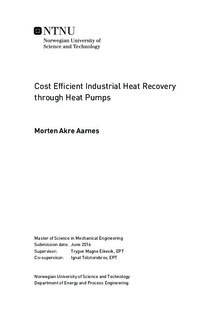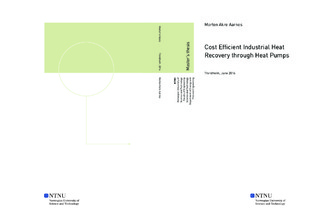| dc.description.abstract | Industrial waste heat often contains large amounts of useable energy that cannot be utilized in its current form, and has to be used together with a waste heating technology to become useful. With increasing energy prices and carbon taxes, efficient use of energy is increasingly important to be able to reduce the net energy consumption and the emissions of greenhouse gases.
This thesis aims at finding suitable, environmentally friendly and high efficiency heat pump solutions for waste heat recovery. This is done for a case where heat is extracted from the flue gas of a natural gas boiler, and used by a heat pump to produce hot water for washing purposes. It is important to have a reliable, efficient and long lasting heat pump, that can provide the desired heat and temperature to show their potential and to further increase their market share.
A review of recent literature was conducted, giving an overview of recent developments in the field. A single-stage vapor compression cycle was chosen to solve the case, and suitable components were found. Simulation models were developed to investigate the performance of the heat pump using R600, R600a and R1234ze(Z) at different operating conditions. The results of the simulations were then used to do economic evaluations of the heat pump in regards to investment and annual costs. The costs of choosing a heat pump over a natural gas boiler were also investigated.
The results from the simulations shows the importance of reducing the losses in the heat pump cycle, especially in the evaporator. By increasing the evaporation temperature, thus the area of the heat exchanger, resulted in a significantly lower pressure drop. This reduced the work input in addition to reduce the required compressor volume and condenser size. R1234ze(Z) achieved the highest COP equal to 3,8 and the lowest annual cost of 325 000 NOK/year resulting in a pay-off time of 3,3 years when compared to a natural gas boiler. R600 achieved higher performance than R600a. The operational costs were the biggest contributor to the annual costs, optimizing the operating conditions for the compressor are therefore of significant importance. This is especially important when the difference in electricity and natural gas prices are large, to be able to be a competitive heating solution.
Heat pumps have the potential to reduce the energy consumption in industrial heating processes and at the same time being a profitable investment, even in markets where the electricity prices are a lot higher than fossil alternatives. However, the importance of optimizing the cycle is increasingly important when the electricity prices are high. A heat pump might cost less to operate yearly than a natural gas boiler, but if the savings are minimal the additional cost might make it in an unprofitable investment. It is therefore important to do economic evaluations when considering to invest in a heat pump solution.
Further work should investigate further improvements to the heat pump cycle. Such as using flooded evaporators, optimizing the suction gas heat exchanger and finding the optimal operating conditions. The required safety measures for the selected refrigerants should also be looked into and how they affect the investment costs. | |

